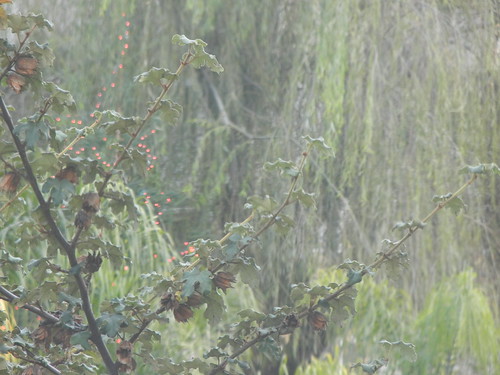Today is the last day of 2010 and also the last day of sales in Artist-Xchange Gallery in San Francisco, where I have exhibited several times in many years.
After nearly seven years of business, the management of this wonderful gallery with close ties to the community of local artists and art lovers decided to close the doors of the 16th St. gallery. According to the management, this decision was based on the continued challenging economic conditions the gallery has faced.
It is a sad event and I heartily thank the gallery for the opportunities to show my work and to meet my art-loving friends and patrons.
Friday, December 31, 2010
2010 Recapitulation
2010 was a busy year for me. This year, I continued my exploration of spatial relationships and patterns, and continued to attend drawing sessions at University of California, Berkeley.
My trip to New York City was very exciting and I visited many museums and galleries and had wonderful encounters with incredible works. Locally, I was excited to see two special exhibits generated from Musee d'Orsay: Birth of Impressionism at De Young Museum, San Francisco and Van Gogh, Gauguin, Cézanne and Beyond: Post-Impressionist Masterpieces from the Musée d’Orsay at De Young Museum, San Francisco.
I also started to use video to present my paintings and drawings. The last offering of these efforts of the year is 2010 Recapitulation:
>> Video presentations of paintings and drawings, Part XVII: Looking Back One More Year
<< Video presentations of paintings and drawings, Part XV: Monochromatic Drama
My trip to New York City was very exciting and I visited many museums and galleries and had wonderful encounters with incredible works. Locally, I was excited to see two special exhibits generated from Musee d'Orsay: Birth of Impressionism at De Young Museum, San Francisco and Van Gogh, Gauguin, Cézanne and Beyond: Post-Impressionist Masterpieces from the Musée d’Orsay at De Young Museum, San Francisco.
I also started to use video to present my paintings and drawings. The last offering of these efforts of the year is 2010 Recapitulation:
>> Video presentations of paintings and drawings, Part XVII: Looking Back One More Year
<< Video presentations of paintings and drawings, Part XV: Monochromatic Drama
Labels:
2010,
My Video,
Recapitulation
Tuesday, December 28, 2010
Art Dealer Accused of Knowing Selling Forged Joan Miró Prints Acquitted
It was reported recently that Pasquale Iannetti, who ran a Sutter Street gallery bearing his name for 37 years was acquitted of knowingly selling fake prints of paintings by Joan Miró.
According to SF Chronicle,
I am glad that he has proved not guilty and that he still has a loyal following. Best of the luck, Mr. Iannetti.
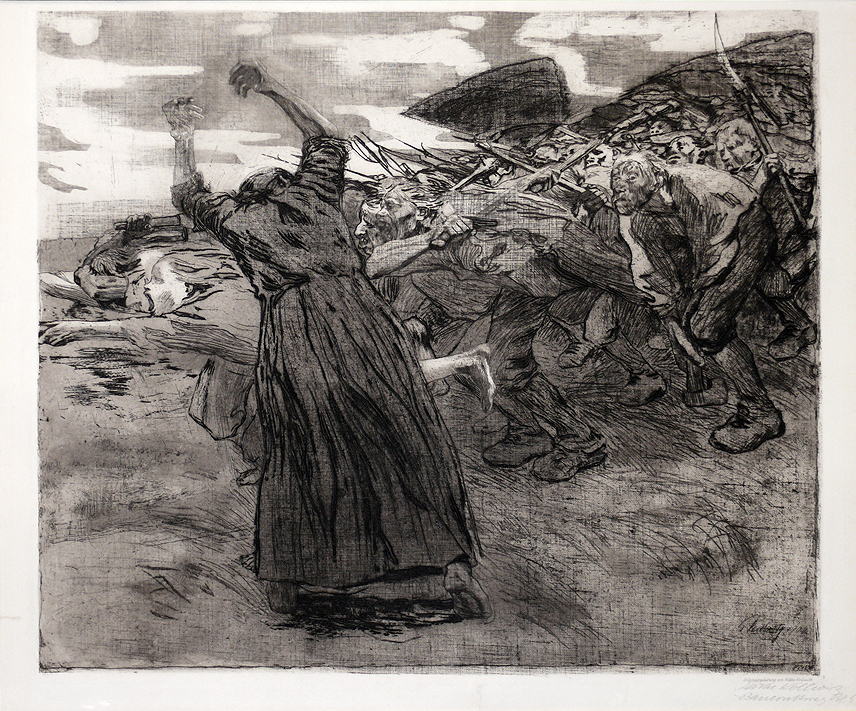
from Bauernkrieg: Losbruch, 1902
( Peasants' War: Charge )
According to SF Chronicle,
When his indictment came to light, I reported it in my blog A Sad Story and an Argument for Buying Living Artists' Works, that I had a very heart-warming encounter wit Mr. Iannetti. When visited the Gallery for a special exhibit of works by the great German artist Käthe Kollwitz. Apparently impressed by my admiration for Kollwitz, Mr. Iannetti gave me a copy of their beautifully produced catalog, which still sits amongst my treasured artbooks on my shelf.
Pasquale Iannetti said he had been unaware he was selling counterfeit prints. A federal court jury in San Francisco found him not guilty of 15 felony counts of mail and wire fraud after 2 1/2 days of deliberations.
Iannetti, 70, was indicted by a federal grand jury in August 2009 for allegedly shipping counterfeit prints that bore the name of Miró, the Spanish painter and sculptor known for his surrealist and expressionist works.
Iannetti closed his gallery shortly after he was indicted but is still selling art from his office and his trying to rebuild his career and his reputation, Dressler said.
"He still has a loyal following," the attorney said.
I am glad that he has proved not guilty and that he still has a loyal following. Best of the luck, Mr. Iannetti.

from Bauernkrieg: Losbruch, 1902
( Peasants' War: Charge )
Saturday, December 25, 2010
Thursday, December 23, 2010
Schadenfreude? Maybe, Maybe Not - On Musical "Spider-man"
 The most expensive musical on Broadway, Spider-Man: Turn Off The Dark has suffered much delays and cast injuries lately. People shifted focus from its production cost of $65 million to the disaster surrounding the musical.
The most expensive musical on Broadway, Spider-Man: Turn Off The Dark has suffered much delays and cast injuries lately. People shifted focus from its production cost of $65 million to the disaster surrounding the musical.Schadenfreude? Maybe. Maybe Not.
The musical's creators are nothing but ambitious in their attempt to stage living theatrical work standing up to comparison to 3-D movies. At 3'58" of the interview video below, Julie Taymor (book and direction) talked about sets, actions, dance etc., but almost nothing about drama. As for characterization, she mentioned in passing that there will be a love interest. The creators talked about their technical accomplishments with greatest enthusiasm but touched upon character, drama and music only perfunctorily. We learned the design of the costume, the pop-up set and flying spider-man over the head of the audience. What about the music? Except that there would be a rock band, we learned nothing. This musical was constructed to shock and awe, rather than to touch and move the audience.
Productions of this scale not only siphon limited resources away from other worthy efforts, they also cultivate an audience who think anything short of an extravaganza might not be of any good. Instead of concentration on dramatic truth, profundity of language, and beauty of music, they lead people into exterior glitter only. Over the years, I have grown extremely weary of over-produced theatrical works.
Living theater has quite different characteristics and validity from those of motion pictures. With the advance of filming techniques, it will be increasingly difficult and extremely foolish to compete with movies on their turf. Instead, theater should focus on what they do best. The effort of such spectacle has also taken a strong foothold in opera world. The Metropolitan Opera's new Ring cycle, produced by Robert Lepage of Cirque du Soleil fame, was such a sad example. Tons of money and time were devoted to make the stage as eye catching as possible while psychological discovery and characterization were almost completely neglected. According to New York Post, "although critics of Met general manager Peter Gelb say costs for the four 'Ring' operas will top $40 million, Met representatives insist the tab will be about $17 million, only slightly above the $4 million per-production average." The audience was again impressed but hardly moved. A much more human scale production would have served the drama of gods (with faults mirroring our humanity) much better.
Tuesday, December 21, 2010
Van Gogh, Gauguin, Cézanne and Beyond: Post-Impressionist Masterpieces from the Musée d’Orsay at De Young Museum, San Francisco
Van Gogh, Gauguin, Cézanne and Beyond: Post-Impressionist Masterpieces from the Musée d'Orsay at De Young Museum, San Francisco (September 25, 2010 - January 18, 2011) is astonishing in its richness and informative in its well thought-out curatorial decisions and descriptions. According to De Young Museum:
There were too many beautiful paintings and I was reluctant not to include almost all my favorites, along with a few other notables for various reasons such as linkage to other artists or movements.
The first painting we saw was the Le Carmencita by John Singer Sargent below. It is a ravishing painting but he hardly belong to this group. I just commented on him a few days ago on his relationship with Impressionism. I believe its inclusion here rather served as a starting point and it contrasted well with other more forward looking pieces:

Le Carmencita, c. 1890, John Singer Sargent
Served as another traditional starting points are Madam Roger Jordain by Albert Besnard and A Dance in the City by Pierre Auguste below. They both had sharp contours, with more restrained and less impressionistic brushwork:
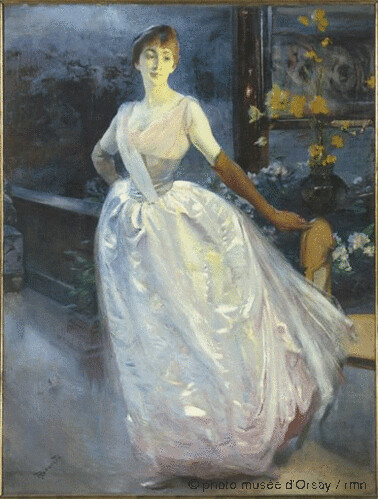
Madam Roger Jordain, 1886, Albert Besnard
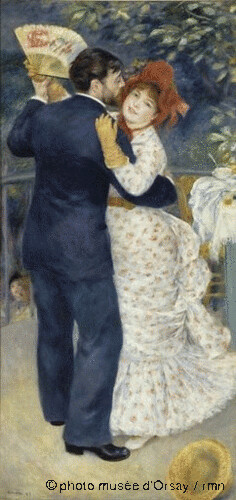
A Dance in the City, 1883, Pierre Auguste Renoir
The Bathers by Renoir, 25 years after A Dance in the City, was typical of Renoir's impressionistic painting with his off-focused, fathery brushstrokes and, sickly sweet palette, evoke a nauseating feelings in me. I really do not like his outputs in this style. This painting however demonstrated how his style evolved well.
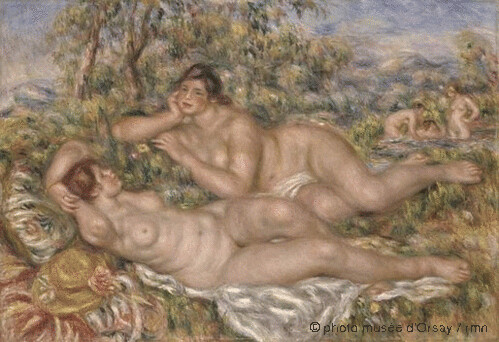
The Bathers, 1918-1919, Pierre Auguste Renoir
Edgar Degas' ballerinas are always popular and he often presented them from most unusual angles, like the piece below, which was full of dynamics:
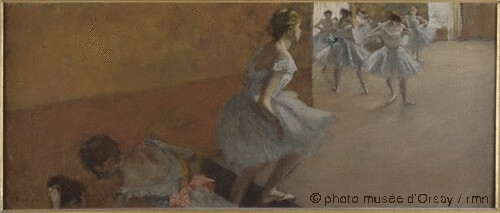
Dancers Climbing the stairs, 1886-1890, Edgar Degas
When we encountered Paul Gauguin, Paul Cézanne and their circles, we are decidedly in the territory of Post-Impressionism, characterized by bold palettes and outlines, often coupled with mythical and symbolical figures and gestures. One can also see the flattening of the plane and drastic abstraction. From Paul Sérucier's works, one could see where Richard Diebenkorn could have come from, or the correspondence with works by Henri Matisse and Paul Cézanne ushered in cubism.
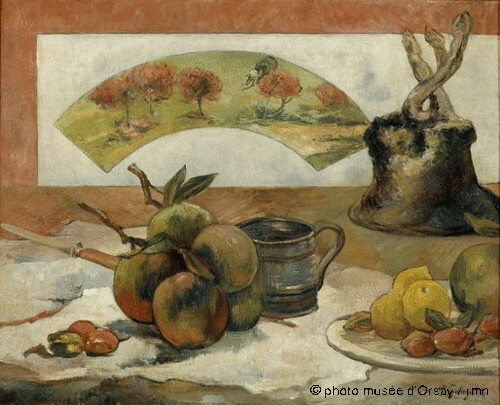
Still Life with Fan, c. 1889, Paul Gauguin - top was obviously influenced by Japanese prints, while the bottom looked like Cézanne's still life
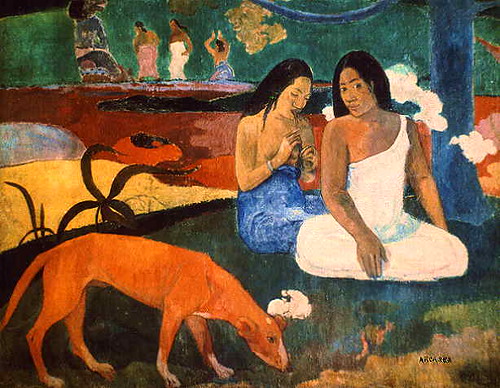
Arearea (Pleasantness), 1892, Paul Gauguin
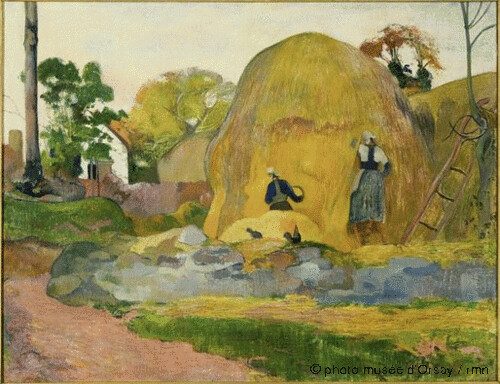
Yellow Haystacks (The Golden Harvest), 1889, Paul Gauguin
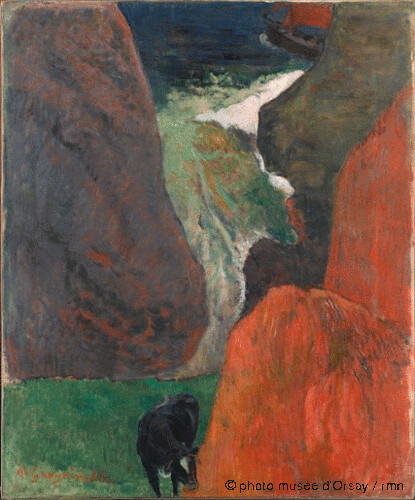
Seascape with Cow (At the Edge of the Cliff), 1888, Paul Gauguin - striking colors, reminded me or Franz Marc
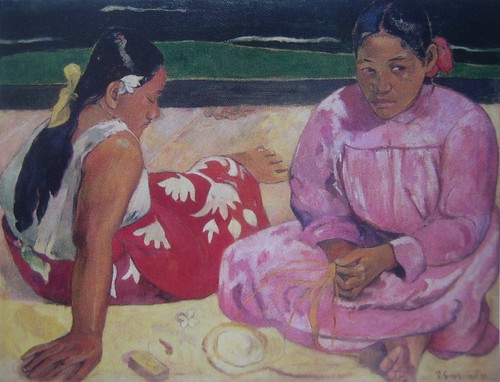
Tahitian Women, 1891, Paul Gauguin
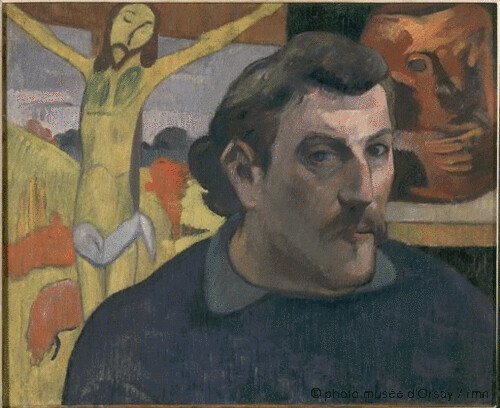
Portrait of the Artist, 1890-91, Paul Gauguin

Bathers with Real Cow, 1887, Emile Bernard
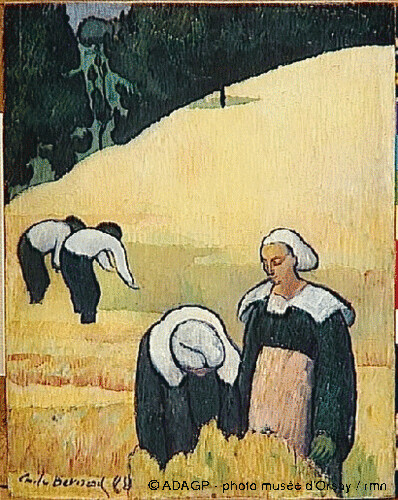
The Harvest (Brefory Landscape), 1888, E'mile Bernard
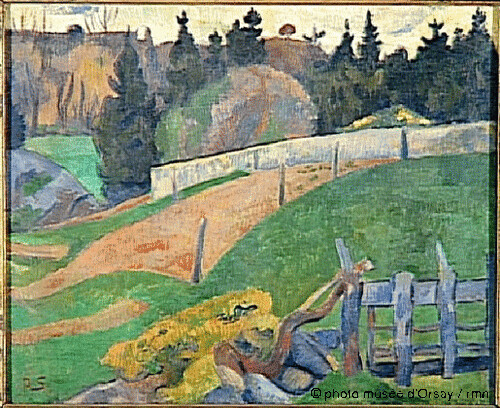
The Flowery Fence, La barrière, 1889, Paul Sérucier

Still Life, The Artist's Studio, 1891, Paul Sérusier
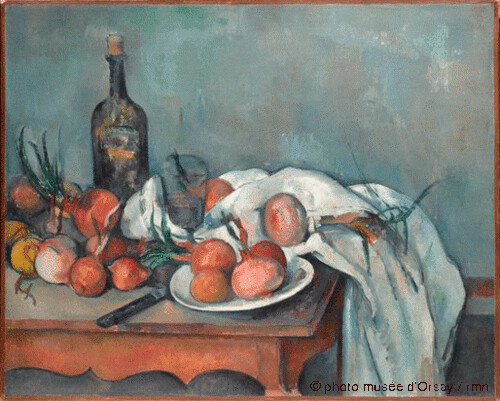
Still Life with Onions, 1896-98, Paul Cézanne
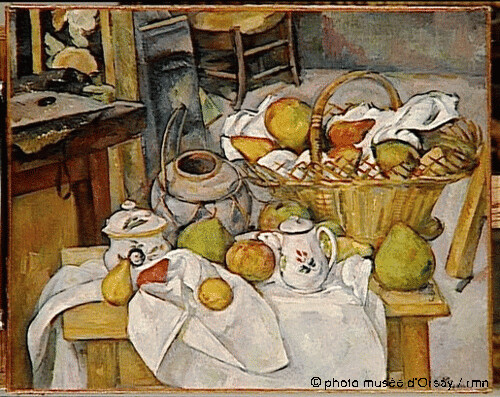
Kitchen Table (Still Life with Basket), 1888-90, Paul Cézanne
The three Cézanne pieces below worth special mentioning. His Bathers had a strange or striking composition, filled with masculine and almost religious figures either blessing or baptizing. Gustave Geffroy, though still representative, clearly pointed a way towards Cubism with its diagonal parallel brushstrokes and Portrait of Madame Cézanne looked back at flat and iconic painting for inspiration and the ancient became new avant-garde:
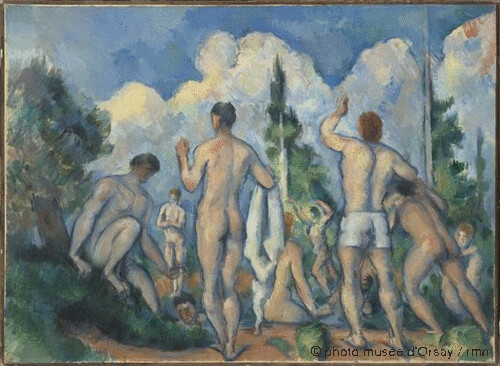
Bathers, c. 1890, Paul Cézanne,
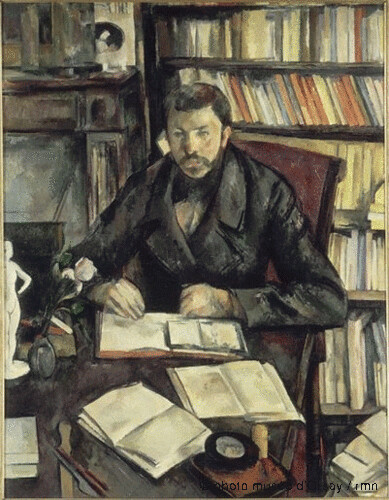
Gustave Geffroy, 1895-96, Paul Cézanne

Portrait of Madame Cézanne, 1885-90, Paul Cézanne
Pointillists are represented by Georges Seurat and surprisingly Camille Pissarro. I have never warmed up to Pointillism and the pieces I liked in this group actually are only borderline Pointillism works - less dotty, more formed, less about science, like the Pissaro and Seurat below and Seurat's studies which demonstrated that he had great facility as a painter.
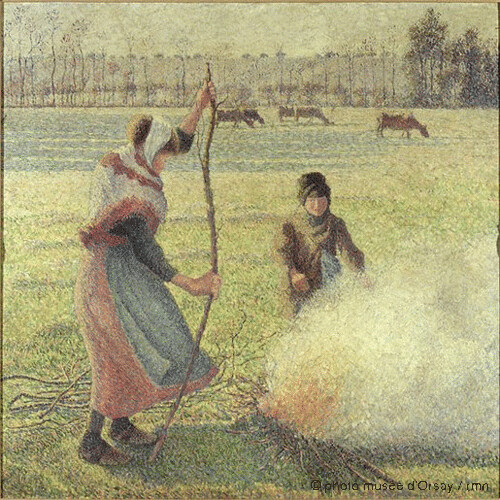
Hoarfrost, Peasant Girl Making a Fire, 1888, Camille Pissarro - pointelistic,

The Little Peasant in Blues, c. 1882, Georges Seurat
Vincent Van Gogh represented the boldest stylistic works in this exhibition (of course others would develop further in other artistic movements). I was really startled by the vivid colors of his 1887 Portrait of the Artist. The image included below looked very dull comparing to the real painting, so did Renoir's Bathers. All the Van Gogh works included here were amazing and I also particularly love his Starry Night and Van Gogh' Bedroom in Arles. The pictures I included below were taken in Musée d’Orsay so my readers can have a sense what they looked like in Paris. The galleries there actually didn't flatter the paintings and hopefully the renovation would make them worthy of the masterpieces they hold.
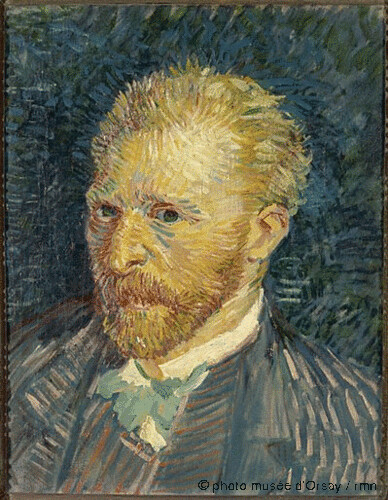
Portrait of the Artist, 1887, Vincent Van Gogh

Starry Night, 1888, Vincent Van Gogh
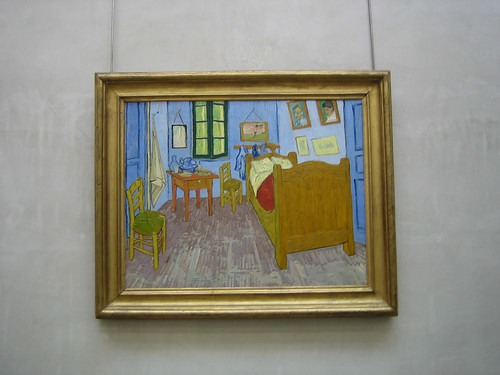
Van Gogh' Bedroom in Arles, 1889, Vincent Van Gogh
Henri de Toulouse-Lautrec was an artist I grew fonder. His caricatures didn't deprive the psychological depths and his Women Pulling Up Her Stockings reminded me more obviously darker works by Egon Schiele.
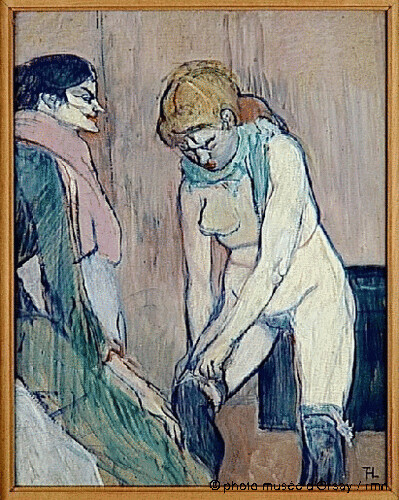
Women Pulling Up Her Stockings, 1894, Henri de Toulouse-Lautrec
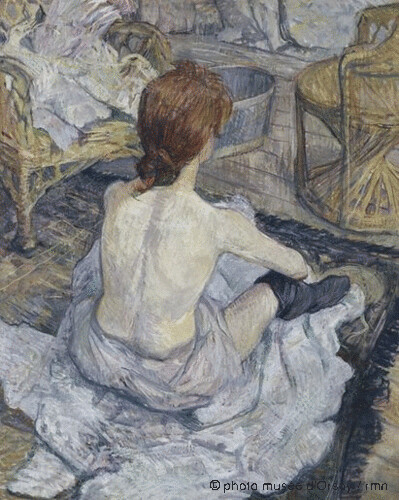
Redhead (Bathing), 1889, Henri de Toulouse-Lautrec
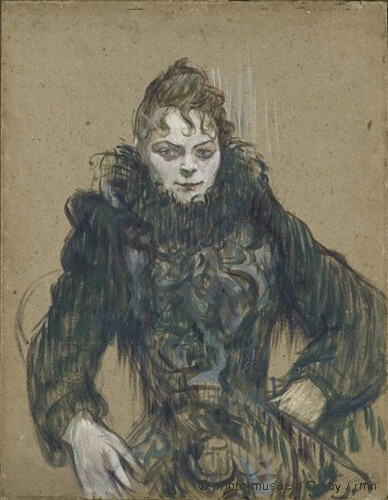
Woman with a Black Boad, 1892, Henri de Toulouse-Lautrec
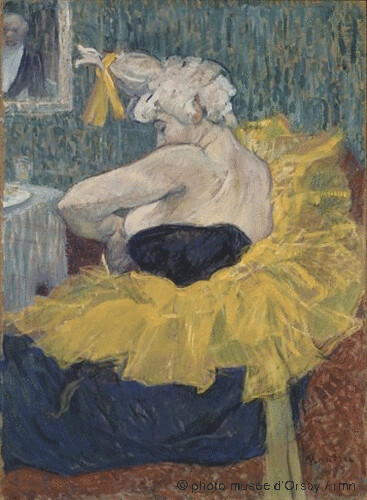
The Clown Cha-U-Kao, 1895, Henri de Toulouse-Lautrec
Next, I was enraptured by another favorite artist of mine - Odilon Redon. I have always loved his mythic subjects and his brilliant color schemes. Even his seemingly dull Eyes Closed is actually ravishingly beautiful, which used the language of symbolism with elements of sleep, death and renaissance bust. His Sleep of Caliban was typical of his style and just breathtakingly lovely.
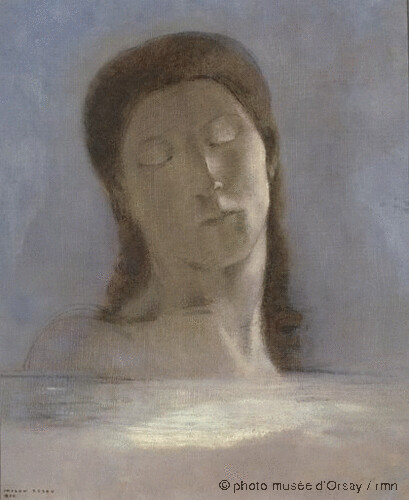
Eyes Closed, 1890, Odilon Redon,
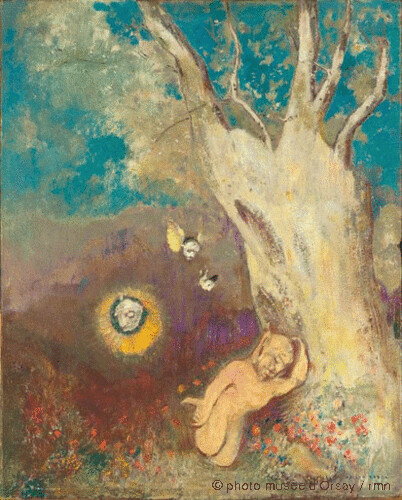
The Sleep of Caliban, 1895-1900, Odilon Redon
The Symbolism "school" included works of varied styles, such as The Poor Fisherman by Pierre Puvis de Chavannes, which employed a Christ-like suffering figure, simplistic and monumental; Orpheus by Gustave Moreau - rich, ornate, pensive and retrospective; and The Snake Charmer, by Henri Rousseau - mysterious, otherworldly and dangerous:
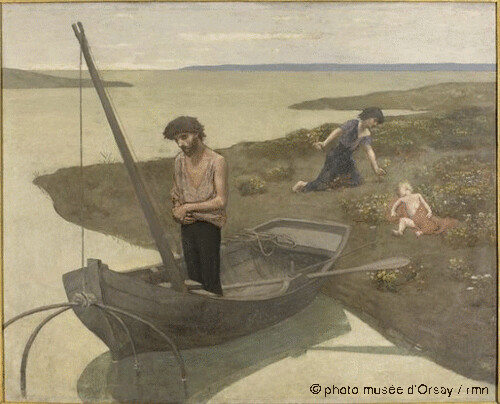
The Poor Fisherman, 1881, Pierre Puvis de Chavannes
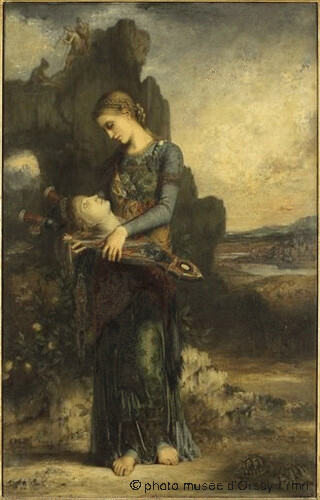
Orpheus, 1865, Gustave Moreau
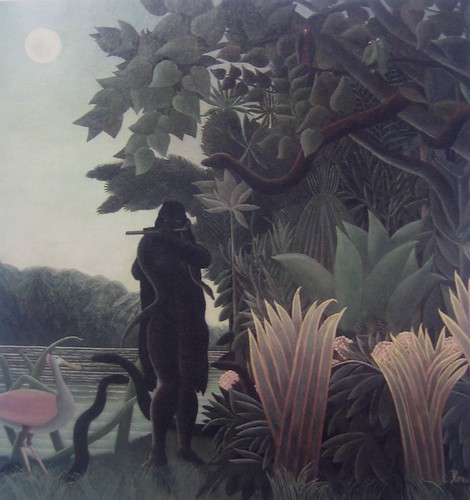
The Snake Charmer, 1907, Henri Rousseau
The sensualist Pierre Bonnard was well represented as well. I love his The Man and the Woman with two lovely contrasted nudes, separated by vertical objects, with the woman small and balled up, and the man stretched full height and confident. The lovely impasto of low value and harmonious paints were a wonder. That can be said of his Woman Dosing on a Bed (Indolent Woman) as well, which boasted beautiful colors, though monochromatic, and looked like the inside of an oyster, lustrous and shining.
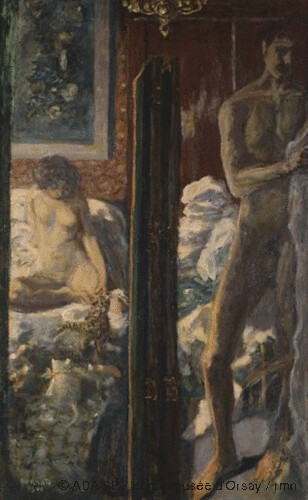
The Man and the Woman, 1900, Pierre Bonnard
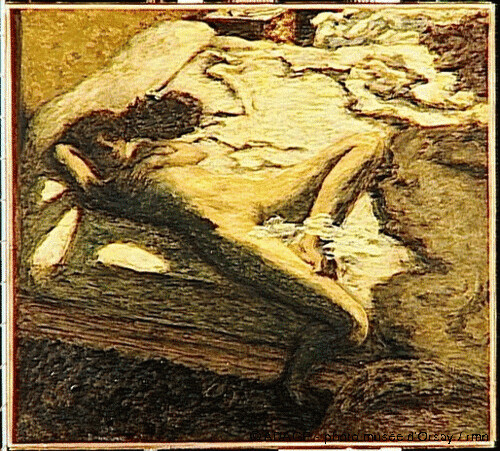
Woman Dosing on a Bed (Indolent Woman), 1899, Pierre Bonnard
I also like his whimsical The White Cat, which somewhat looked like a work by Toulouse-Lautrec:
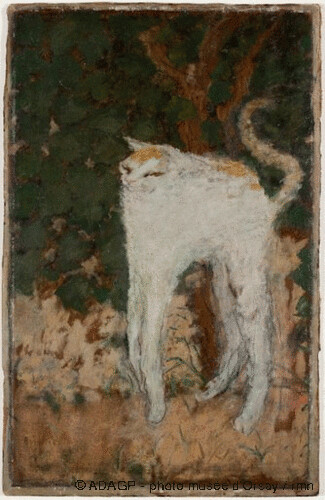
The White Cat, 1896, Pierre Bonnard
What I don't like were his two decorative panels: Water Games (The Voygage) and Pleasure (not pictured) - with their ghastly orange decorative borders, they looked rather like representations of easy-going hell:
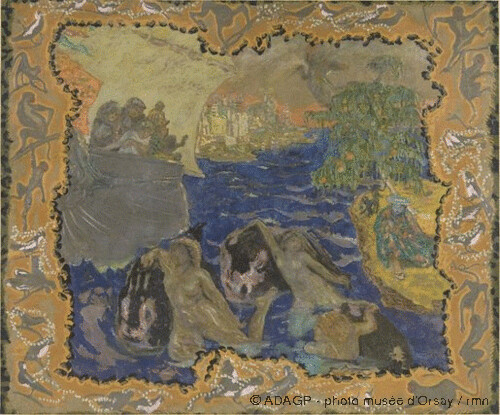
Decorative Panel: Water Games (The Voygage), 1906-10, Pierre Bonnard
Other works could be described as somewhat decorative are quite lovely, though The Talisman, the Aven at the Boss d'Amour by Paul Sérusier was rather semi-abstract but it did have design quality to it so I mention it in this group.
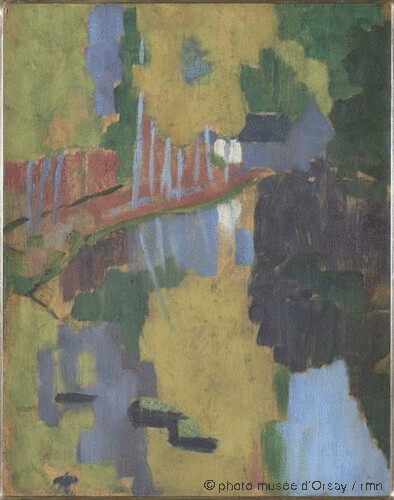
The Talisman, the Aven at the Boss d'Amour, 1888, Paul Sérusier
Other such "decorative" works included those by Maurice Denis and Ker-Xavier Roussel. They were also lovely and not without deeper meanings. Calling them decorative did not mean they were shallow, especially Landscape with Green Trees (Green Trees) (Procession Under the Trees) by Maurice Denis, which could be called symbolism work as well:
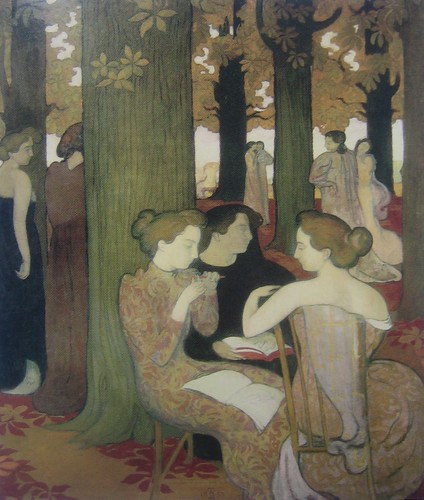
The Muses, 1893, Maurice Denis
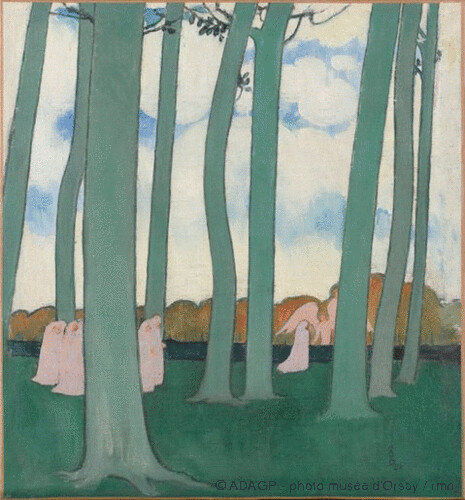
Landscape with Green Trees (Green Trees) (Procession Under the Trees), 1893, Maurice Denis
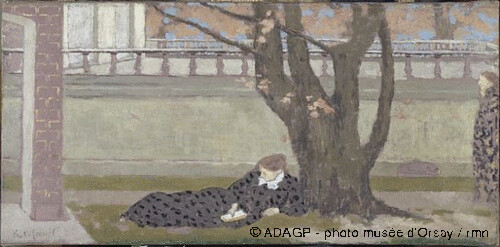
The Terrace, c. 1892, Ker-Xavier Roussel
It was a most exulted exhibit and I would go back again in two weeks' time.
During this wonderful run, De Young Museum was hit by a little controversy regarding sketching in the museum. Apparently someone tried to make sketches in this crowded show and was told not to. In order to clarify the matter, De Young Museum published its sketching policy online:
This was a sensible policy therefore I felt no need to call for a sketching-in.
Thank you, De Young Museum.
The second of two exhibitions from the Musée d'Orsay's permanent collection, Van Gogh, Gauguin, Cézanne and Beyond: Post-Impressionist Masterpieces from the Musée d'Orsay follows on the heels of the first with a selection of the most famous late-Impressionist paintings by Claude Monet and Auguste Renoir, as well as works representing the individualist styles of the early modern masters, including Vincent van Gogh, Henri de Toulouse-Lautrec, Paul Gauguin, and the Nabis Pierre Bonnard and Édouard Vuillard.
It is here where the Orsay's collection shines brightest with masterpieces such as Van Gogh's Starry Night over the Rhone, a haunting Portrait of the Artist, and Bedroom at Arles. The exhibition includes a superior collection of paintings from the Pont-Aven school, including Gauguin's masterpiece Self-Portrait with The Yellow Christ. The exhibition concludes with the Orsay's spectacular collection of pointillist paintings, represented by the masters Georges Seurat and Paul Signac.
The de Young is the only museum in North America to host the exhibition.
There were too many beautiful paintings and I was reluctant not to include almost all my favorites, along with a few other notables for various reasons such as linkage to other artists or movements.
The first painting we saw was the Le Carmencita by John Singer Sargent below. It is a ravishing painting but he hardly belong to this group. I just commented on him a few days ago on his relationship with Impressionism. I believe its inclusion here rather served as a starting point and it contrasted well with other more forward looking pieces:

Le Carmencita, c. 1890, John Singer Sargent
Served as another traditional starting points are Madam Roger Jordain by Albert Besnard and A Dance in the City by Pierre Auguste below. They both had sharp contours, with more restrained and less impressionistic brushwork:

Madam Roger Jordain, 1886, Albert Besnard

A Dance in the City, 1883, Pierre Auguste Renoir
The Bathers by Renoir, 25 years after A Dance in the City, was typical of Renoir's impressionistic painting with his off-focused, fathery brushstrokes and, sickly sweet palette, evoke a nauseating feelings in me. I really do not like his outputs in this style. This painting however demonstrated how his style evolved well.

The Bathers, 1918-1919, Pierre Auguste Renoir
Edgar Degas' ballerinas are always popular and he often presented them from most unusual angles, like the piece below, which was full of dynamics:

Dancers Climbing the stairs, 1886-1890, Edgar Degas
When we encountered Paul Gauguin, Paul Cézanne and their circles, we are decidedly in the territory of Post-Impressionism, characterized by bold palettes and outlines, often coupled with mythical and symbolical figures and gestures. One can also see the flattening of the plane and drastic abstraction. From Paul Sérucier's works, one could see where Richard Diebenkorn could have come from, or the correspondence with works by Henri Matisse and Paul Cézanne ushered in cubism.

Still Life with Fan, c. 1889, Paul Gauguin - top was obviously influenced by Japanese prints, while the bottom looked like Cézanne's still life

Arearea (Pleasantness), 1892, Paul Gauguin

Yellow Haystacks (The Golden Harvest), 1889, Paul Gauguin

Seascape with Cow (At the Edge of the Cliff), 1888, Paul Gauguin - striking colors, reminded me or Franz Marc

Tahitian Women, 1891, Paul Gauguin

Portrait of the Artist, 1890-91, Paul Gauguin

Bathers with Real Cow, 1887, Emile Bernard

The Harvest (Brefory Landscape), 1888, E'mile Bernard

The Flowery Fence, La barrière, 1889, Paul Sérucier

Still Life, The Artist's Studio, 1891, Paul Sérusier

Still Life with Onions, 1896-98, Paul Cézanne

Kitchen Table (Still Life with Basket), 1888-90, Paul Cézanne
The three Cézanne pieces below worth special mentioning. His Bathers had a strange or striking composition, filled with masculine and almost religious figures either blessing or baptizing. Gustave Geffroy, though still representative, clearly pointed a way towards Cubism with its diagonal parallel brushstrokes and Portrait of Madame Cézanne looked back at flat and iconic painting for inspiration and the ancient became new avant-garde:

Bathers, c. 1890, Paul Cézanne,

Gustave Geffroy, 1895-96, Paul Cézanne

Portrait of Madame Cézanne, 1885-90, Paul Cézanne
Pointillists are represented by Georges Seurat and surprisingly Camille Pissarro. I have never warmed up to Pointillism and the pieces I liked in this group actually are only borderline Pointillism works - less dotty, more formed, less about science, like the Pissaro and Seurat below and Seurat's studies which demonstrated that he had great facility as a painter.

Hoarfrost, Peasant Girl Making a Fire, 1888, Camille Pissarro - pointelistic,

The Little Peasant in Blues, c. 1882, Georges Seurat
Vincent Van Gogh represented the boldest stylistic works in this exhibition (of course others would develop further in other artistic movements). I was really startled by the vivid colors of his 1887 Portrait of the Artist. The image included below looked very dull comparing to the real painting, so did Renoir's Bathers. All the Van Gogh works included here were amazing and I also particularly love his Starry Night and Van Gogh' Bedroom in Arles. The pictures I included below were taken in Musée d’Orsay so my readers can have a sense what they looked like in Paris. The galleries there actually didn't flatter the paintings and hopefully the renovation would make them worthy of the masterpieces they hold.

Portrait of the Artist, 1887, Vincent Van Gogh

Starry Night, 1888, Vincent Van Gogh

Van Gogh' Bedroom in Arles, 1889, Vincent Van Gogh
Henri de Toulouse-Lautrec was an artist I grew fonder. His caricatures didn't deprive the psychological depths and his Women Pulling Up Her Stockings reminded me more obviously darker works by Egon Schiele.

Women Pulling Up Her Stockings, 1894, Henri de Toulouse-Lautrec

Redhead (Bathing), 1889, Henri de Toulouse-Lautrec

Woman with a Black Boad, 1892, Henri de Toulouse-Lautrec

The Clown Cha-U-Kao, 1895, Henri de Toulouse-Lautrec
Next, I was enraptured by another favorite artist of mine - Odilon Redon. I have always loved his mythic subjects and his brilliant color schemes. Even his seemingly dull Eyes Closed is actually ravishingly beautiful, which used the language of symbolism with elements of sleep, death and renaissance bust. His Sleep of Caliban was typical of his style and just breathtakingly lovely.

Eyes Closed, 1890, Odilon Redon,

The Sleep of Caliban, 1895-1900, Odilon Redon
The Symbolism "school" included works of varied styles, such as The Poor Fisherman by Pierre Puvis de Chavannes, which employed a Christ-like suffering figure, simplistic and monumental; Orpheus by Gustave Moreau - rich, ornate, pensive and retrospective; and The Snake Charmer, by Henri Rousseau - mysterious, otherworldly and dangerous:

The Poor Fisherman, 1881, Pierre Puvis de Chavannes

Orpheus, 1865, Gustave Moreau

The Snake Charmer, 1907, Henri Rousseau
The sensualist Pierre Bonnard was well represented as well. I love his The Man and the Woman with two lovely contrasted nudes, separated by vertical objects, with the woman small and balled up, and the man stretched full height and confident. The lovely impasto of low value and harmonious paints were a wonder. That can be said of his Woman Dosing on a Bed (Indolent Woman) as well, which boasted beautiful colors, though monochromatic, and looked like the inside of an oyster, lustrous and shining.

The Man and the Woman, 1900, Pierre Bonnard

Woman Dosing on a Bed (Indolent Woman), 1899, Pierre Bonnard
I also like his whimsical The White Cat, which somewhat looked like a work by Toulouse-Lautrec:

The White Cat, 1896, Pierre Bonnard
What I don't like were his two decorative panels: Water Games (The Voygage) and Pleasure (not pictured) - with their ghastly orange decorative borders, they looked rather like representations of easy-going hell:

Decorative Panel: Water Games (The Voygage), 1906-10, Pierre Bonnard
Other works could be described as somewhat decorative are quite lovely, though The Talisman, the Aven at the Boss d'Amour by Paul Sérusier was rather semi-abstract but it did have design quality to it so I mention it in this group.

The Talisman, the Aven at the Boss d'Amour, 1888, Paul Sérusier
Other such "decorative" works included those by Maurice Denis and Ker-Xavier Roussel. They were also lovely and not without deeper meanings. Calling them decorative did not mean they were shallow, especially Landscape with Green Trees (Green Trees) (Procession Under the Trees) by Maurice Denis, which could be called symbolism work as well:

The Muses, 1893, Maurice Denis

Landscape with Green Trees (Green Trees) (Procession Under the Trees), 1893, Maurice Denis

The Terrace, c. 1892, Ker-Xavier Roussel
It was a most exulted exhibit and I would go back again in two weeks' time.
During this wonderful run, De Young Museum was hit by a little controversy regarding sketching in the museum. Apparently someone tried to make sketches in this crowded show and was told not to. In order to clarify the matter, De Young Museum published its sketching policy online:
We'd like to take a moment to clarify the museum's sketching policy, in light of the recent and rather controversial article in the San Francisco Chronicle. We welcome and encourage artists to be inspired by and learn from our collections—sketching is permitted for all visitors in the permanent collection galleries at both the de Young and Legion of Honor. With prior notice and approval, artists can also use easels and paints in the permanent collection galleries.
Rules about sketching in traveling exhibitions are determined by two factors—the agreement with the lending institution or collector, and the volume of visitors to an exhibition. Lenders often prohibit sketching in proximity to their works of art when on view at another museum instead of in their own galleries. Sketchers have a tendency to limit crowd flow by blocking access to popular paintings for a long period of time. Because we are the only museum in North America to host Van Gogh, Gauguin, Cezanne and Beyond our daily attendance is very high. With the galleries so crowded, it is virtually impossible to allow sketching.
Come sketch in the museum's permanent collection galleries this weekend, December 18 and 19. The first 20 visitors to check in at the de Young's information desk on Saturday and Sunday will receive a complimentary sketch pad, pencil, and one general admission pass to the permanent collection galleries.
This was a sensible policy therefore I felt no need to call for a sketching-in.
Thank you, De Young Museum.
Sunday, December 19, 2010
Pixar Exhibit and Newly Renovated Oakland Museum of California
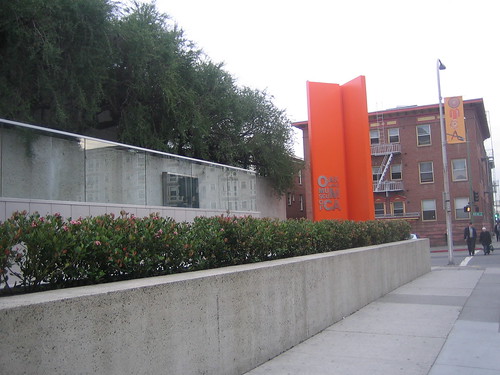
Oakland Museum of California
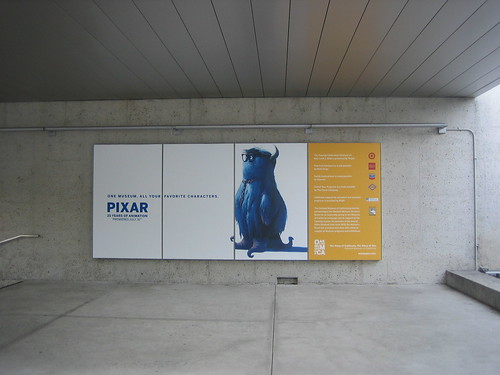
Pixar Exhibit Poster
Last Thursday, I visited Oakland Museum of California, which had just undergone a renovation. The special exhibit is Pixar - 25 Years Animation exhibit, which has traveled the world and now came back home to the East Bay. It was educational and fun exhibit. Pixar's talents were truly amazing. Unavoidably, this kind show will have some dull part but mostly amusing. I am inclined to seek out copies of Finding Nemo and An Insect's Life and that is a proof that I was quite taken in by the exhibit. The exhibit runs from July 31, 2010 through January 9, 2011.
I also took time to visit the permanent collections of Oakland Museum of California. The museum has three parts - History, Nature and Art. There are many interesting installations around the building, starting with Ruth Asawa's 1974 untitled piece, which greeted visitors at the entrance. There are also many interesting viewed from windows inside the museum:
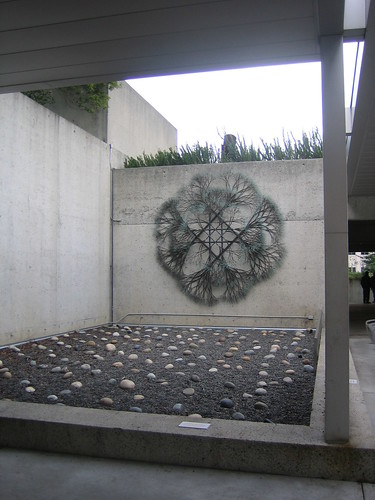
Untitled, 1974, Ruth Asawa, Bronze wire and copper pipe
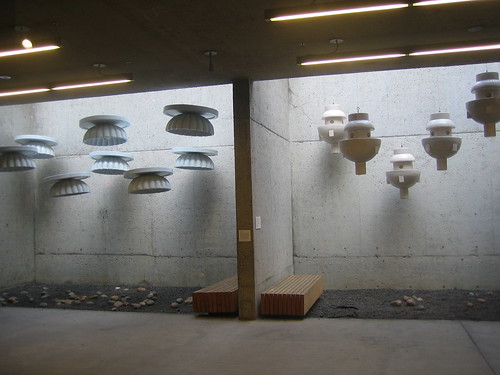
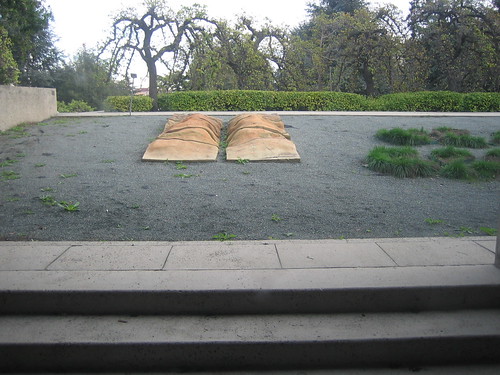
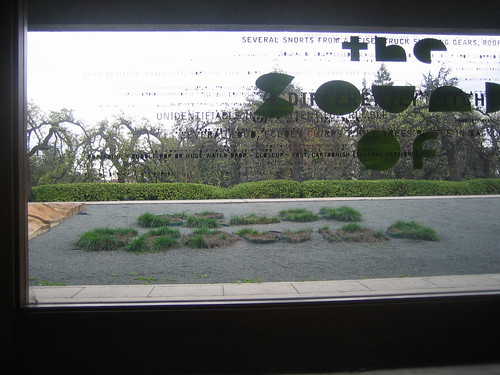
The collections in the art galleries are arranged thematically. It will be a nightmare for visitor to museums in much grander size but for this one, it worked just fine.
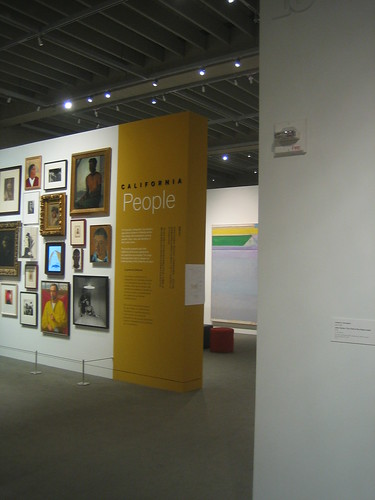
In order to keep my thoughts more organized, I decide to present artworks I enjoy in chronological order, rather than following their leads.
There are many paintings by "California" school, particularly by Richard Diebenkorn. But the collections went back to late 19th century and till current time. It also contain some graphic arts and photographies:
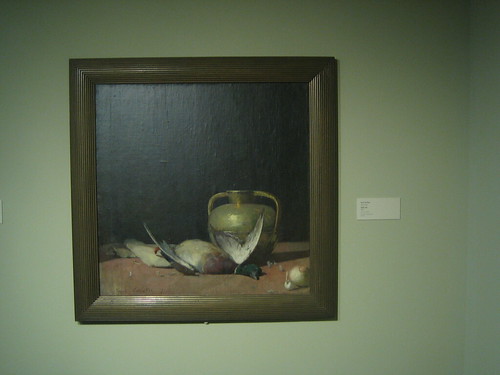
Still Life, 1891, Oil on Canvas, Emil Carlsen

Nocturnal Street Scene, Early 20th Century, Oil on Canvas, Charles Rollo Peters
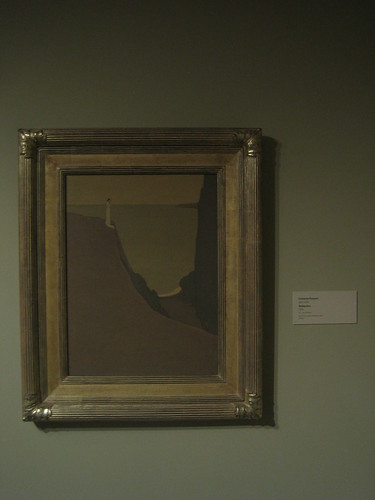
Reflection, 1904, Oil on Canvas, Gottardo Piazzoni
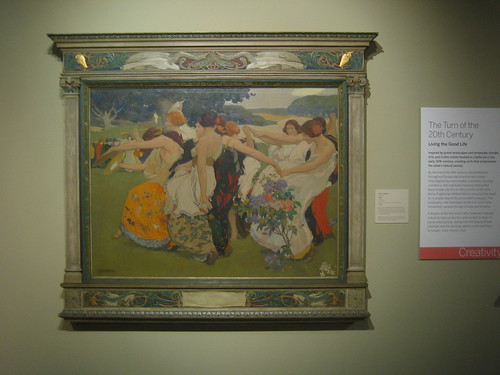
Youth, c. 1917, Oil on Canvas, Arthur F. Matthews

Boat and Yellow Hill, c. 1920s, Oil on Canvas, Selden Connor Gile

Untitled, 1947, Oil on Canvas, Mark Rothko
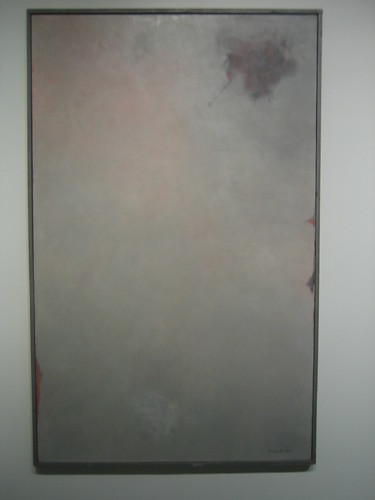
Untitled, 1949, Oil on Canvas, Edward Corbett
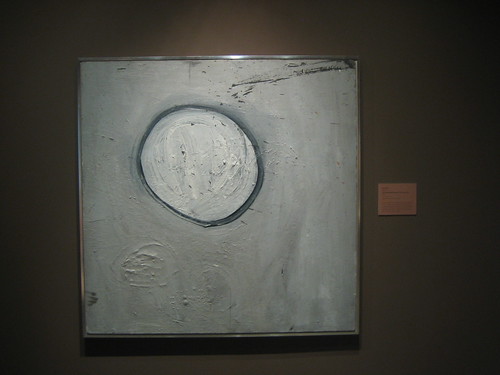
The Illustrated History of the Universe, 1955, Oil on Masonite, Jay DeFeo
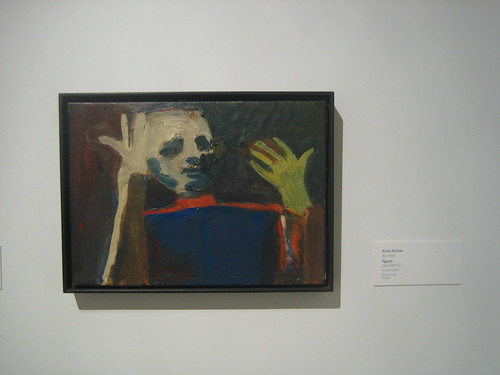
Figure, c. 1956-57, Oil on Canvas, Bruce McGaw
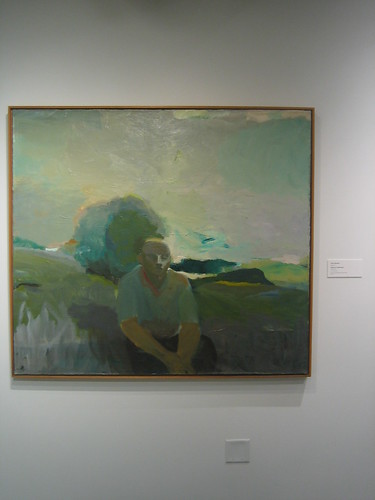
Figure in Landscape, c. 1957, Elmer Bischoff
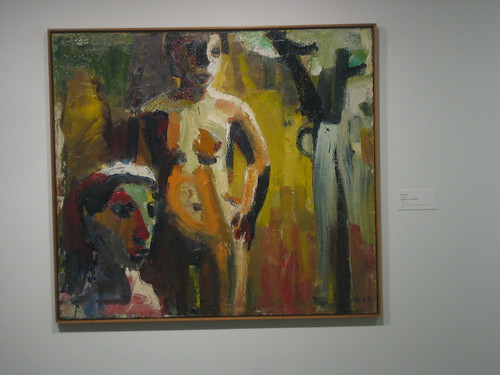
Women in Landscape, 1958, Oil on Canvas, David Park
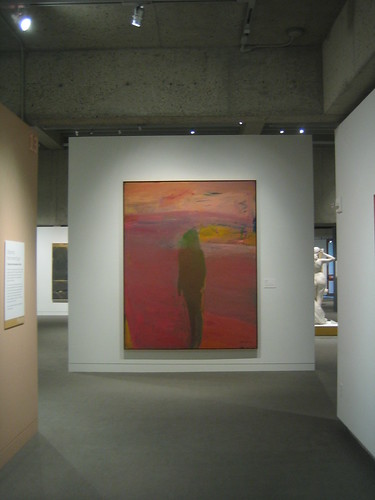
Spring Nude, 1962, Oil on Canvas, Nathan Oliveira
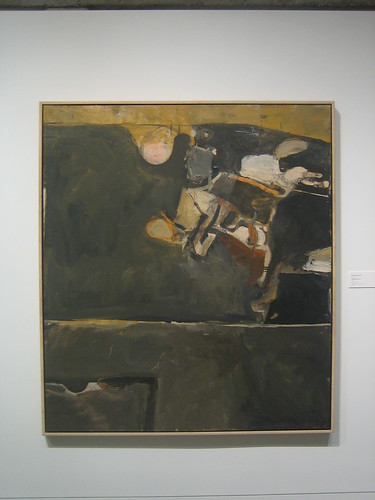
Berkeley No. 20, 1954, Oil on Canvas, Richard Diebenkorn
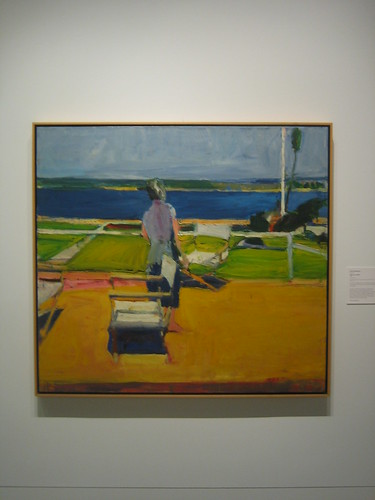
Figure on a Porch, 1959, Oil on Canvas, Richard Diebenkorn
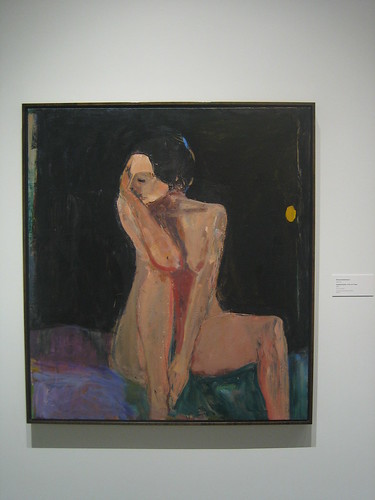
Seated Nude - Arm on Knee, 1962,Oil on Canvas, Richard Diebenkorn
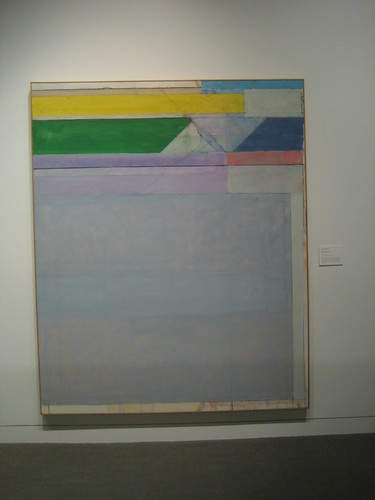
Ocean Park No. 107, 1978, Oil on Canvas, Richard Diebenkorn
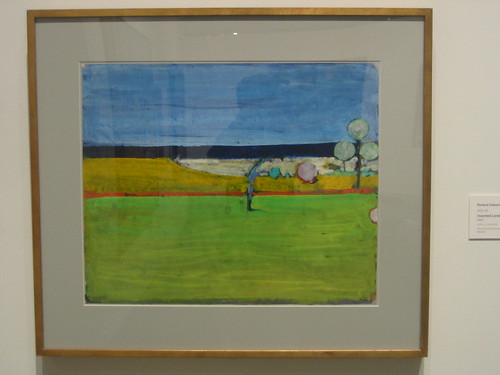
Invented Landscape, 1966, Acrylic on Paper, Richard Diebenkorn
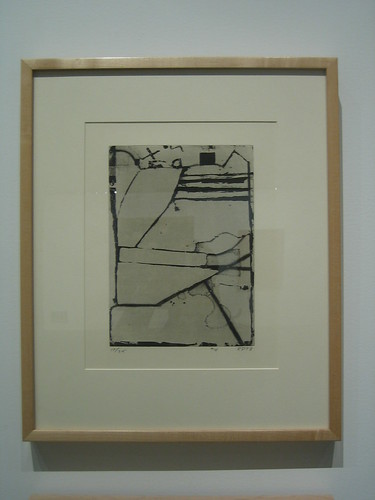
#4, 1978, Aquatint, Etching, and Drypoint, Richard Diebenkorn

Upper Sacramento Vally, 1985, Type-C Color Pint, Reagan Louie
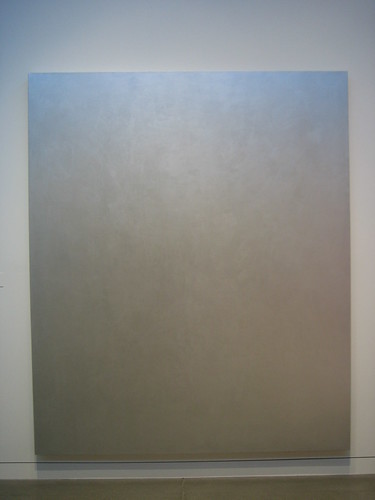
Free State, 1994, Acrylic on Canvas, David Simpson
Away from two-dimensional works, I group them into Ceramics, Decorative Works and Sculptures, Installations and Videos.
Ceramics:
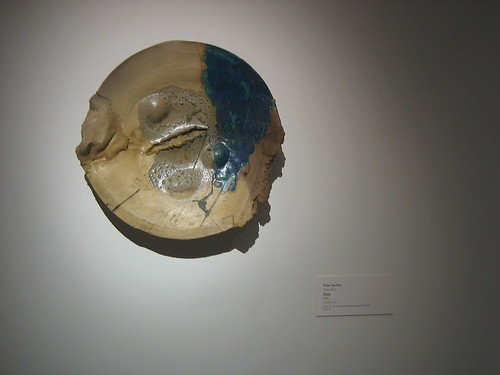
Plate, 1962, Glazed Clay, Peter Voulkos, Oakland Museum of California

Electrical Insulator, 1900-1975, Glazed Ceramic (Hollow)
Sculptures and Installations:
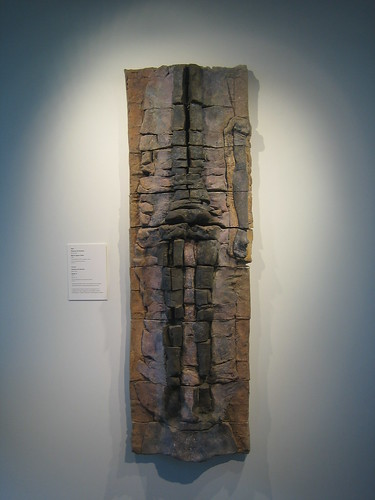
Black Figure Stele, 1975, Stoneware with Polychrome Stains, Stephen de Staebler

Never-Ending Screen, 1974, Aluminum, Claire Falkenstein

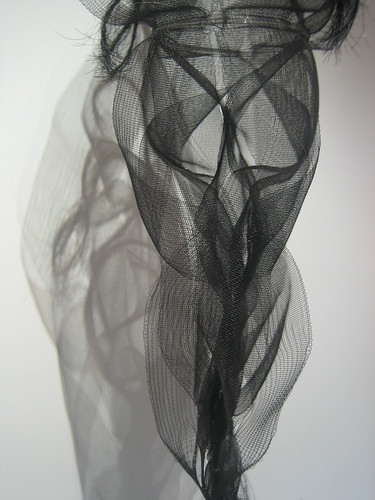
Amiyose III, 1965, Monofilament, Dye, and Fiber, Kay Seklmachi
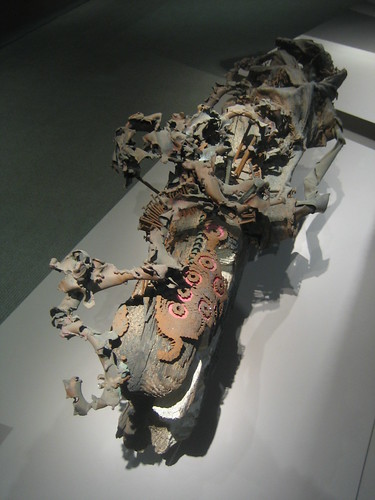
Untitled, c, 1959-60, Copper Tube, Wood, Nail, Burlap, and Fiberglass, Seymour Locks
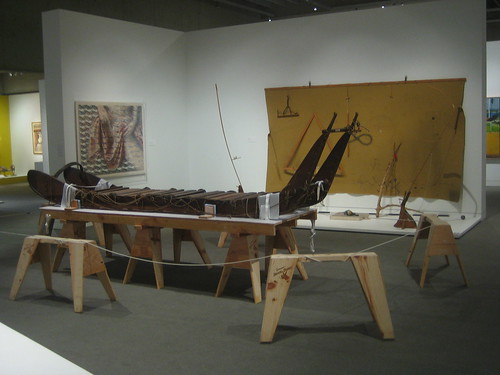
Left wall: Point of Touch: Bathsheba, 1995, Linen, Ryon, Oil Paint, ad Dye, Lia Cook // Backwall: How to Charter a Coarse, 1971, Mixed Media, William T. Wiley
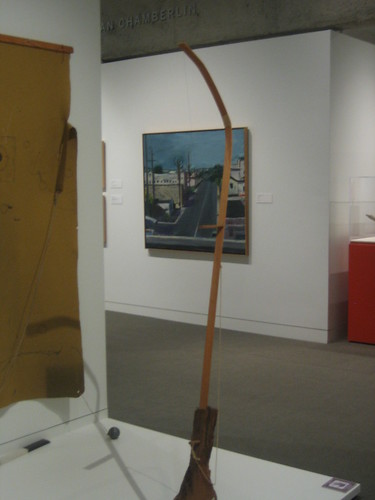
Installation at the front: How to Charter a Coarse, 1971, Mixed Media, William T. Wiley // Painting at the back: Stree, 1961, Oil on Canvas, Richard Diebenkorn
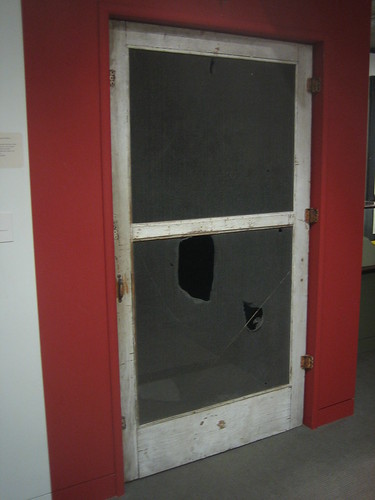
Aristotle's Cage, 1983-92, Mixed media installation, Michael C. McMillen

Untitled, 1967, Coated Glass, Plexiglass, and Metal Stripping, Larry Bell
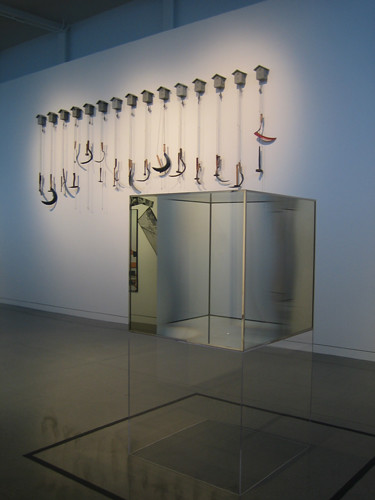
Just a Matter of Time, 1990, Mixed Media, Paul Kos and Untitled, 1967, Coated Glass, Plexiglass, and Metal Stripping, Larry Bell
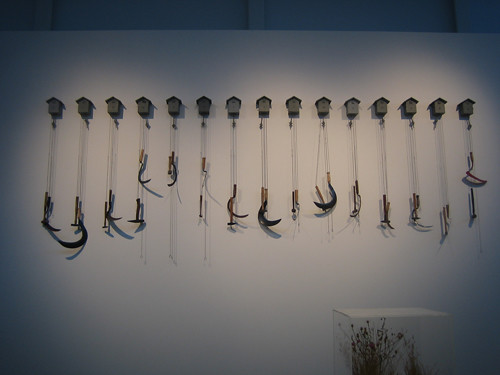
Just a Matter of Time, 1990, Mixed Media, Paul Kos, Oakland Museum of California
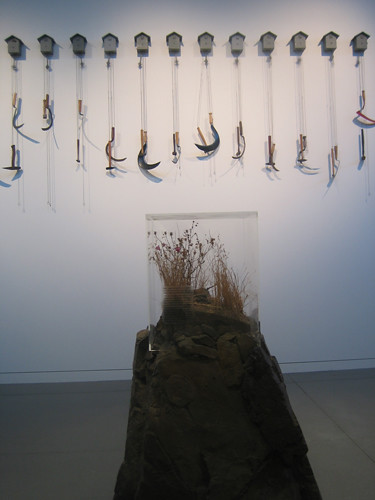
Just a Matter of Time, 1990, Mixed Media, Paul Kos and "Yard of Earth", a simple ecological system, Oakland Museum of California
Video:
Color Combination, 2000, Color DVD with Sound, Kota Ezawa
Decorative art and historical artifacts:
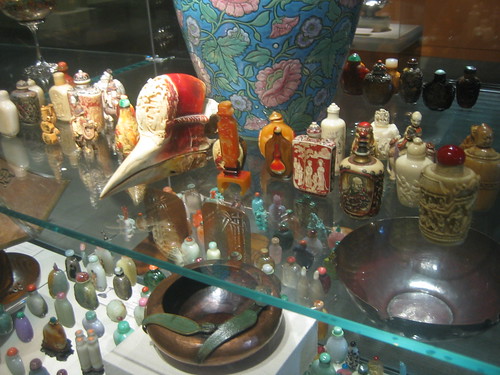
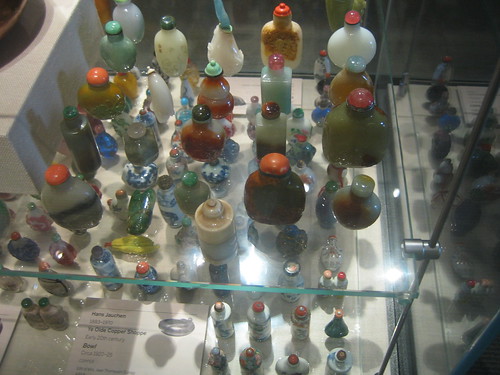
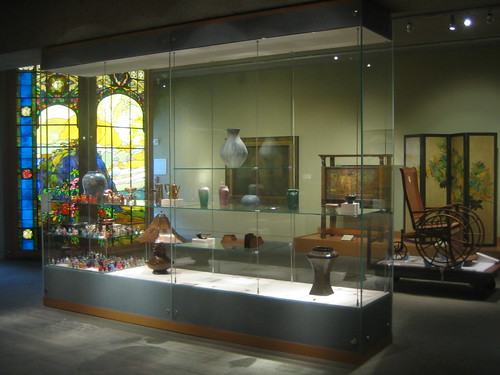
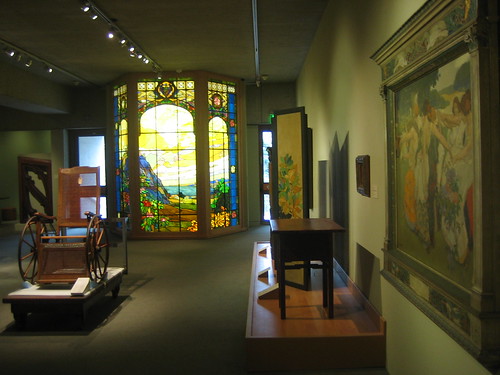
Franc Pierce Hammon Memorial Windows, 1925, Leaded Stained Glass, Arthur F. Matthews
Then, a little bit of history:

An Artist's Studio, Early 20th Century Style

Curatorial Departments, 19th century natural scientist bureau
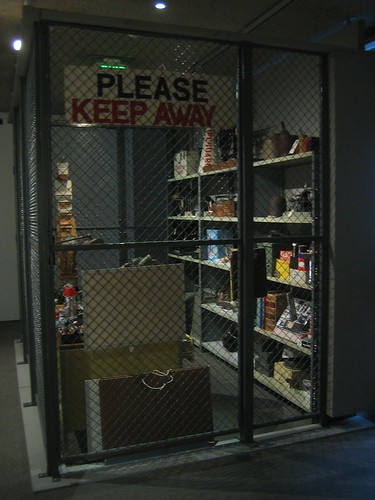
Curatorial Departments, 1976 history department office
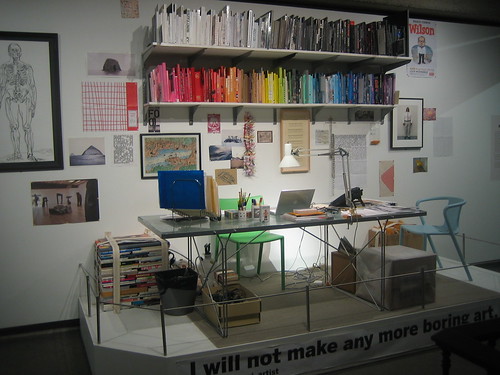
Curatorial Departments, present-day contemporary art
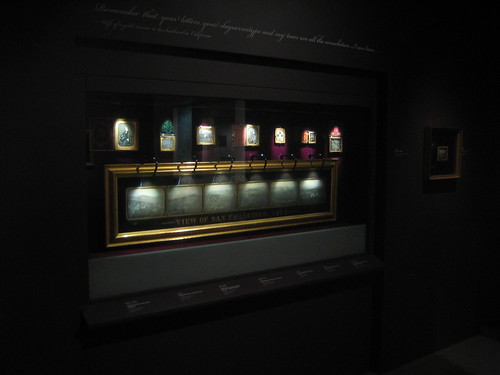
View of San Francisco, 1853, Unknown, Six whole plate daguerreotypes in vintage frame
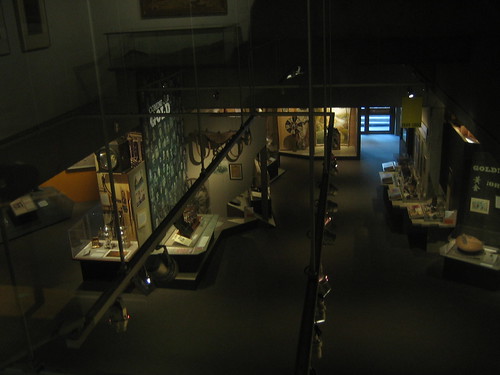
Looking down to the history gallery - California's Gold Rush era
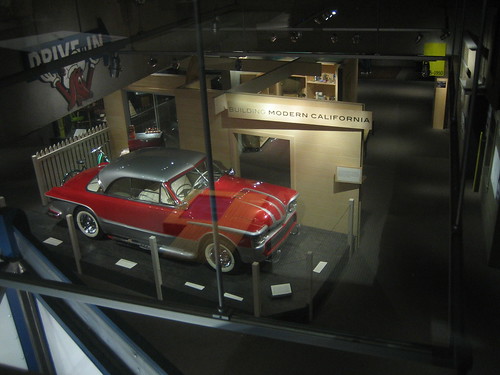
Looking down to the history gallery - California in the decades after World War II
Subscribe to:
Comments (Atom)

